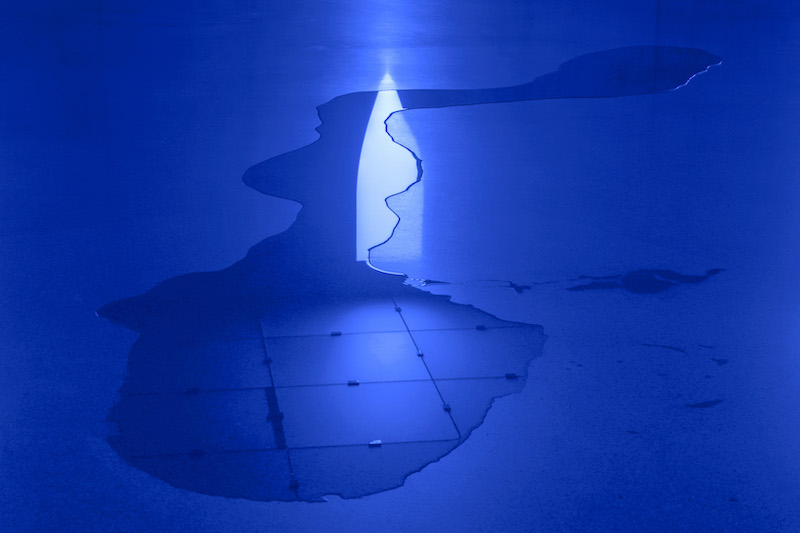by Giannina Herion // June 29, 2021
In her first solo exhibition ‘House of Meme’ at KUB Kunsthaus Bregenz, Pamela Rosenkranz addresses the fluid interrelations of the evolution between sensory perception, artefacts and human kind.
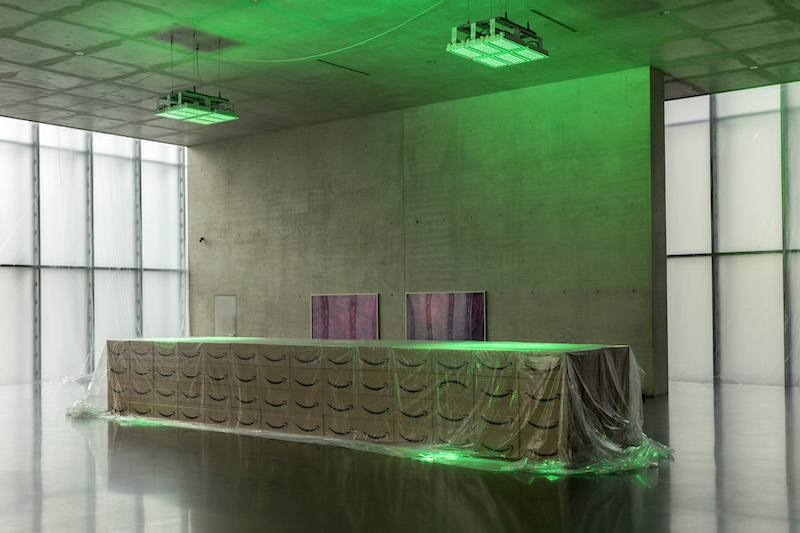
Pamela Rosenkranz: ‘House of Meme,’ installation view first floor, Kunsthaus Bregenz, 2021 // Photo by Markus Tretter, Courtesy of the artist © Pamela Rosenkranz, Kunsthaus Bregenz
Entering the ground floor, one is confronted with a huge box covered by a layer of loose hanging plastic foil reflecting artificial green LED spotlights. On the walls: stock-images. Close-ups of green forests covered by a wild thin layer of pink-violet color. Who owns nature? Walking around the big box one discovers that it is built out of many Amazon branded boxes. A smiling arrow as a logo. Alexa’s voice lists all available Amazon products in a looping echo. Not only named after the longest river in the world, but also used to inspire its organizational structure, Amazon became the world’s largest online marketplace and Jeff Bezos is the richest human. Cartons are made of wood. The online market booms. The Amazon rainforest burns. It’s connected. The term “meme” derives from “mimesis,” or “imitation,” and was coined by Richard Dawkins in ‘Survival of the Fittest,’ for the transmission and mutation of cultural codes like ideas or behavioral patterns analogue to the biological level of genes. In popular culture, it is used for online content that is spread quickly as a viral image with slight variations.
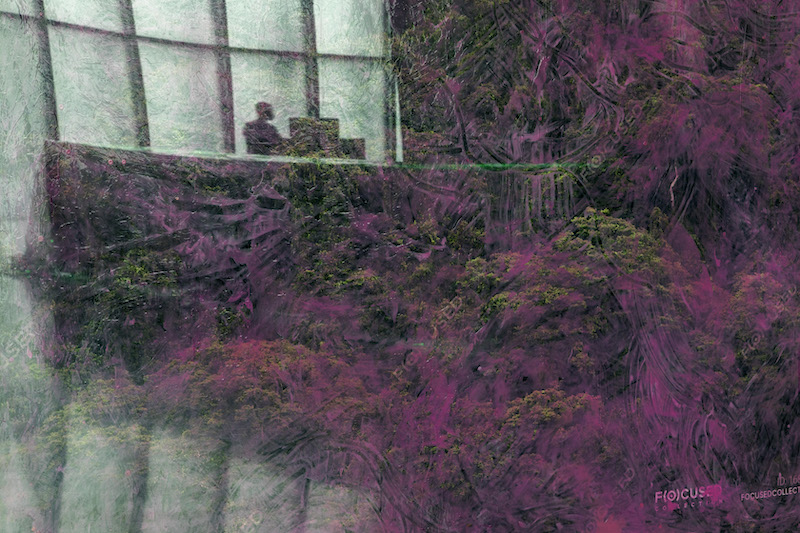
Pamela Rosenkranz: ‘House of Meme,’ installation view ground floor, Kunsthaus Bregenz, 2021 // Photo by Markus Tretter, Courtesy of the artist © Pamela Rosenkranz, Kunsthaus Bregenz
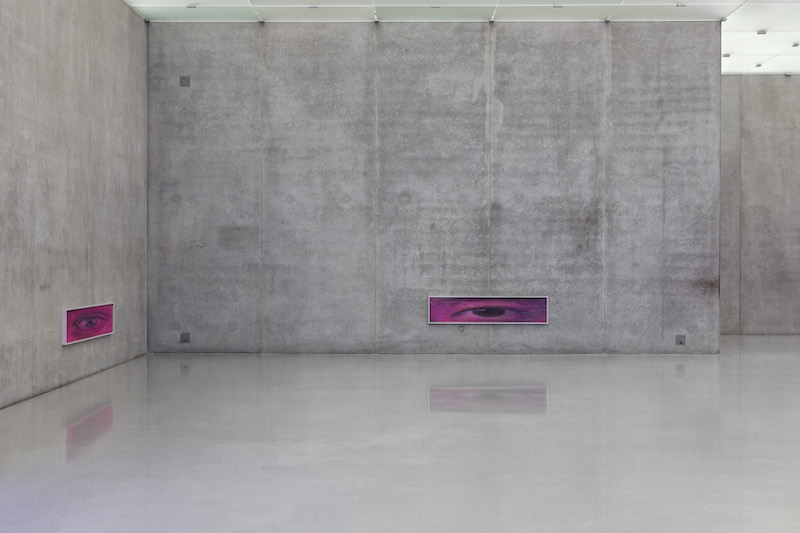
Pamela Rosenkranz: ‘House of Meme,’ installation view first floor, Kunsthaus Bregenz, 2021 // Photo by Markus Tretter, Courtesy of the artist © Pamela Rosenkranz, Kunsthaus Bregenz
On the second floor of the exhibition, Gothic-shaped, luminous windows appear like bright blue-screens on the wall. In between the blue windows, Rosenkranz placed stock images of eyes with traces of watermarks covered by a pink filter. What do we see? Everything we see is light—a mixture of multiple wavelengths. Our human ancestors are believed to have been colorblind. Today, most humans have 3 types of cone cells in their eyes that are sensitive to red, green and blue light. Usually, human brains can register around 100 different color shades. Still, we only see a small part of the electromagnetic spectrum. Color vision might have developed because it allowed some primates to recognize red and orange fruits better in the background of the green jungle. As a genetic mutation, they developed those three different types of light sensitive cone cells in their eyes. Various types of bats only see shades of black, white and gray, while chimpanzees are able to perceive the color spectrum of a rainbow, a dog can detect gray, yellow and blue in soft tones and rats are able to perceive ultraviolet radiation. Birds see colors that are invisible to us. Where we see a black bird, they see a colorful one. Only a very small number of humans possess a kind of superhuman vision and are able to detect around 100 million colors. The history of the evolution of the brain, the eye and vision, is endlessly fascinating, going back over 90 million of years and is being elaborated by contemporary scientists, combining different fields from biophysics, quantum chemistry, microbiology and genetic engineering.
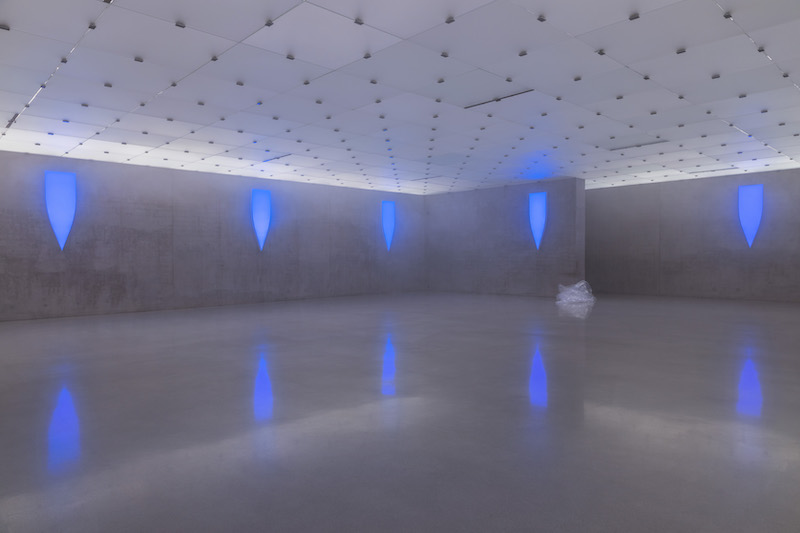
Pamela Rosenkranz: ‘House of Meme,’ installation view second floor, Kunsthaus Bregenz, 2021 // Photo by Markus Tretter, Courtesy of the artist © Pamela Rosenkranz, Kunsthaus Bregenz
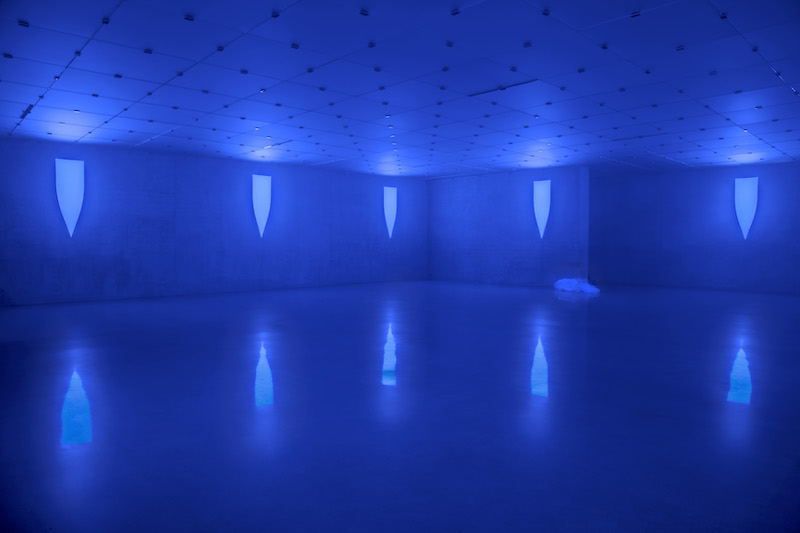
Pamela Rosenkranz: ‘House of Meme,’ installation view second floor, Kunsthaus Bregenz, 2021 // Photo by Markus Tretter, Courtesy of the artist © Pamela Rosenkranz, Kunsthaus Bregenz
On the third floor, there’s fog in the air. A slight smell of burning. An immersive sea of blue coming from the blue Gothic-style window screens—the windows transform into white and the white fog into blue, when I try to grasp the installation with my camera. My camera and I have different visions of color and, on each of your screens, the blue will look and be seen slightly differently. The nature of digital imagery is based on the imitation of colored rays through a transparent skin. The emptiness of the glowing screen links to its depths. Computing can be seen as an ouroboric transformational process of coding and decoding. Links to the history of the usage of blue in artworks arise. International Klein Blue. Ultramarine blue. Originally made of lapis lazuli, mined in Afghanistan. The Latin word “ultramarinus” means “beyond the sea.” The pigment was imported to Europe by the Italians. As the most expensive color pigment, it was used by artists in the Renaissance, mainly as a sacred color of God for the blue robes of the Virgin Mary.
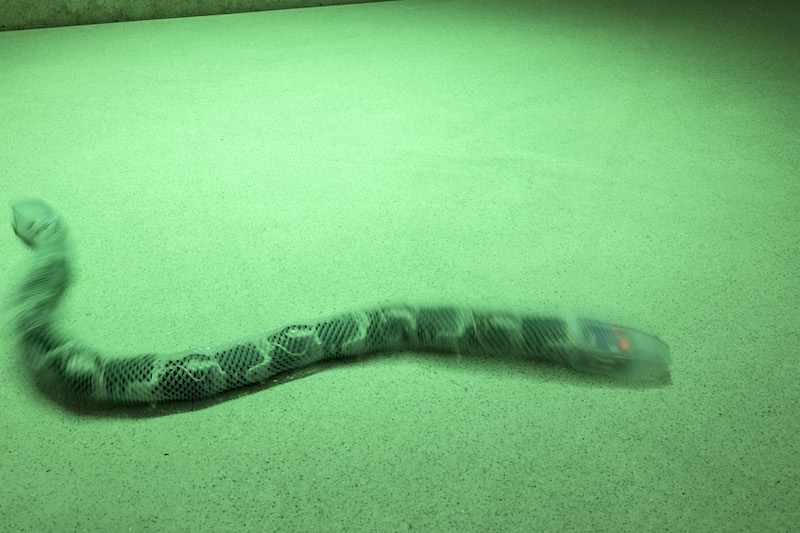
Pamela Rosenkranz: ‘House of Meme,’ installation view third floor, Kunsthaus Bregenz, 2021 // Photo by Markus Tretter, Courtesy of the artist © Pamela Rosenkranz, Kunsthaus Bregenz
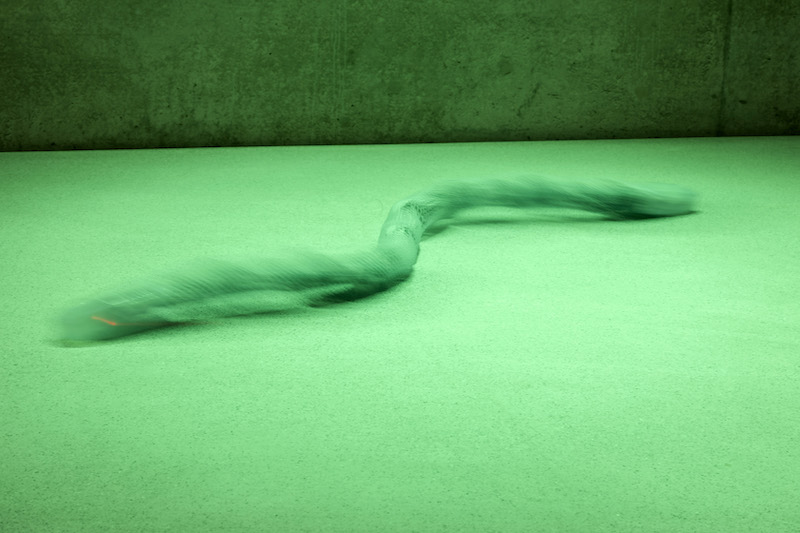
Pamela Rosenkranz: ‘House of Meme,’ installation view third floor, Kunsthaus Bregenz, 2021 // Photo by Markus Tretter, Courtesy of the artist © Pamela Rosenkranz, Kunsthaus Bregenz
On the top floor of KUB, ‘Healer (Waters)’ (2019), an abandoned AI-endowed serpent, is moving in unpredictable wave lines under green flashing spotlights. Shiny, fresh plastic tubes are placed in corners, as if the snake-robot has just shed its skin. Since the age of paleolithic cave paintings, snakes have been present as a symbol in our visual culture. In Buddhism and Hinduism, snakes are holy creatures. In the Bible, they are the first mentioned animal representing the cycle of life and death. In mythology, one may find many more meanings, from fertility to protection and healing. Snake venoms can heal or kill. You could program an artificial snake to kill, to dance, to jump like a frog or sing like Bud Spencer. How could it heal?
Rosenkranz’ installations are closely interwoven with KUB’s architecture by Peter Zumthor. Plastic foils cover the ceiling-high windows, softening the concrete corners in a crumpled state or becoming shimmering light reflectors. On the frosted glass ceiling, cables wind, as if they are documenting the artificial animal’s movements. In Japanese culture, robots—like stones or plants—are part of the spiritual world. Shintoism, the major religion in Japan, offers a broader worldview than the concepts of western beliefs. Everything is perceived as being interconnected and part of one unity. All things are part of a form of homogenous cosmic consciousness, even if on the surface they appear to be inanimate and non-sentient. In philosophy, it is discussed as “the oneness hypothesis.”
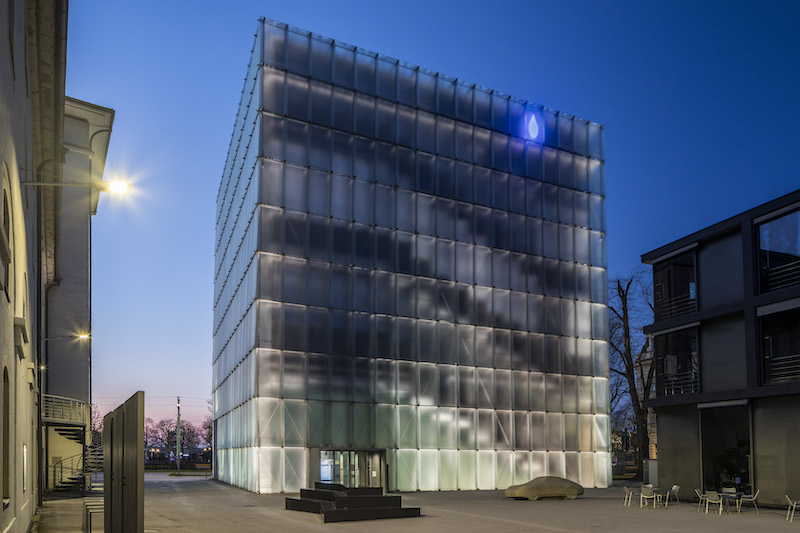
Pamela Rosenkranz: ‘House of Meme,’ front view, Kunsthaus Bregenz, 2021 // photo by Markus Tretter, Courtesy of the artist © Pamela Rosenkranz, Kunsthaus Bregenz
Nearly all elements in our human bodies are made of stardust, stemming mostly from supernovae—the last hurrahs of dying stars—over the course of billions of years. We live on a blue marble, we also come from the water. In our current geological age, human impact is seen to be dominantly changing the Earth and its atmosphere, leading to increases in global rates of extinction and the destruction of biodiversity. Natural resources are limited. Humans are able to create new artefacts. It seems that western culture’s dualism of subject/object and culture/nature has lost its connection—the “being in between.” Pamela Rosenkranz reminds us of this in a wide space of associations and dissociations. Her multi-sensory artistic practice might sharpen the perception of our human condition as an osmotic medium in an interconnected vibrating energy field. To use technology like artificial intelligence, to solve urgent problems of our times while connecting with our roots, appears like a little sunbeam in the darkness of contemporary doom scenarios. Nonetheless, let’s just think of the “worst case scenario” for us: we die out and transform into another matter. How will other aliens perceive us through the fossils of our civilization?
On July 4th, there will be an artist talk with Pamela Rosenkranz at KUB. Rosenkranz’ work is currently also part of the group show ‘Sun Rise | Sun Set’, running until August 27th at Schinkel Pavillon in Berlin.
Exhibition Info
Kunsthaus Bregenz
Pamela Rosenkranz: ‘House of Meme’
Finissage & Artist Talk: Sunday, July 4; 5pm
Exhibition: Apr. 17–July 4, 2021
kunsthaus-bregenz.at
Karl-Tizian-Platz, 6900 Bregenz, click here for map


